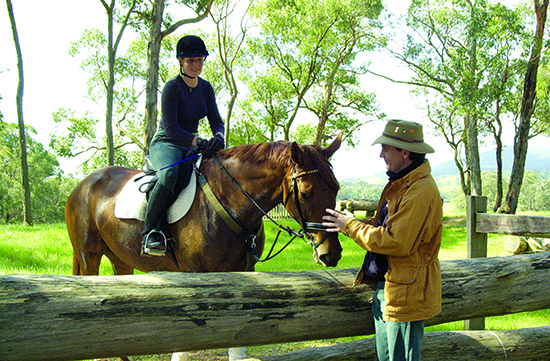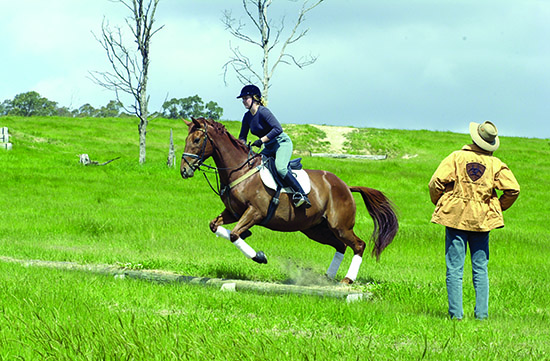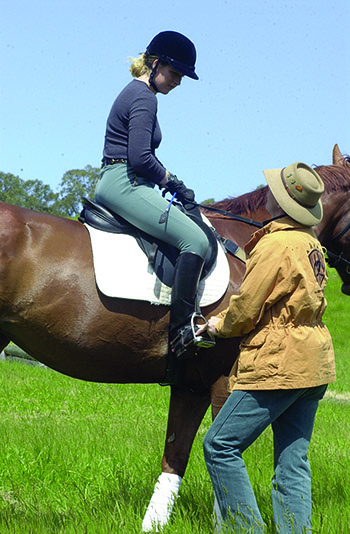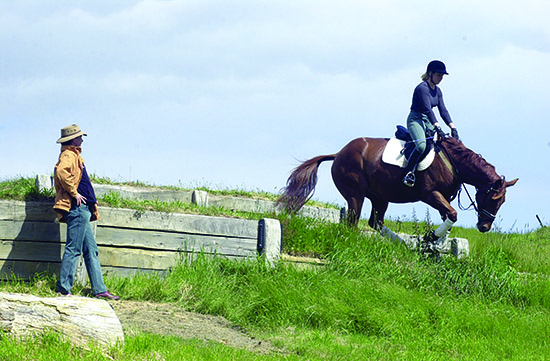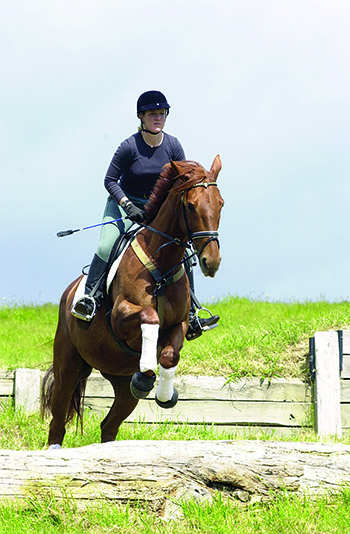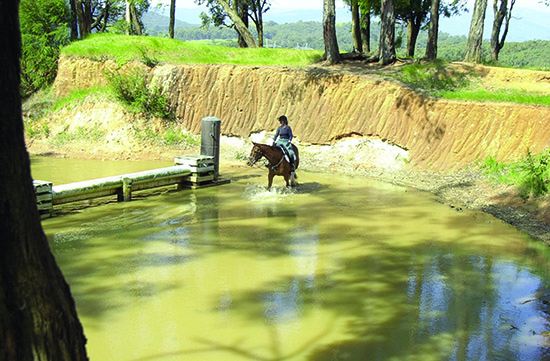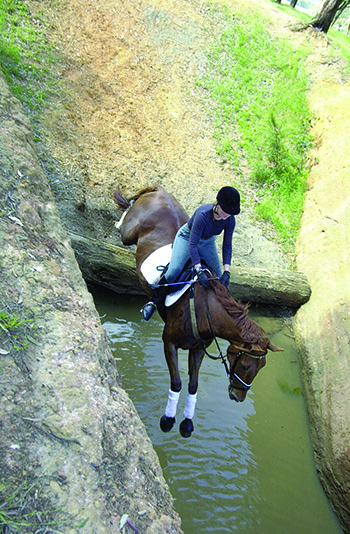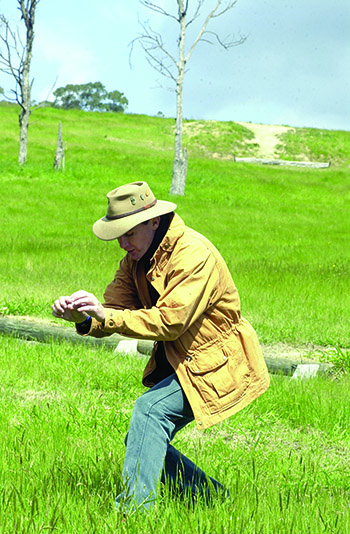While most children grow up playing with sand pits and garden swings, Emily Anker grew up more or less in the middle of one of Australia’s classiest cross country tracks, teaching her pony tricks on obstacles built by the redoubtable Captain Mark Phillips who was, when he wasn’t upgrading the course, advising her parents, Angela and John on ways to make their One Day Event even more attractive to the general public.
Time flies, Em is no longer blitzing them in the Shetland Derby but now making her way through open eventing ranks, competing three star on Estabon and Stolen Success, her name marked down on the list of young riders to watch.
It was an exciting combination to put together, triple gold medallist, Matt Ryan and Emily and her lovely seven year old mare, Blind Love, alias Betty, for a special lesson over some of the schooling fences at Wandin.
We all know what a great competitor Matt Ryan is, but he is also a natural teacher, all that inherited Ryan passion and enthusiasm combined with a cool and calculating analytical mind and competition experience that is second to none.
We started out on a little schooling ditch, and the mare was really quite spooky, with Matt trying to keep everything cool and calm. Suggesting that Emily take her time, only hassling the mare when she took a step away, and taking the pressure off immediately she moved towards the jump… It was, said Matt, all in the mind:
“Cross country schooling and riding doesn’t take a lot of physical effort: ditches, steps down, into water, for those sort of fences you don’t need the horse to be physically strong, or capable of jumping big fences, if you have problems they are more likely to be mental problems. The psychological problem is to keep the horse confident and bold enough to feel ‘this is okay’. For young horses, ditches in particular are a problem, they think they are filled with demons and dragons and they really hate the sight of them.”
“I like the idea of a horse being able to understand what is going on, so particularly in training, I don’t like coming up to ditches and trying to force the horse over. I want the horse to come up, have a look down and check it out a little bit. To do this, you have to start with a ditch that is quite small. If – and when – the horse spooks, don’t try to hassle it over too quickly. When they’ve had a look, you say ‘come on let’s go over it’. If they back off, then hassle them a little bit – don’t get too rough with them, just let them know that in heading anywhere other than the direction of the ditch, they are going to be hassled. As soon as the horse stops going backwards, or sideways, and is actually going towards the ditch, back off. Reward the horse – so the horse feels that he is being rewarded for heading in the direction you want.”
“With a really green horse, or a spooky horse, that might take a little while but as long as you are consistent with that philosophy, eventually the horse will realise that the only nice place to go is over that spooky ditch because whenever he’s gone anywhere else, you’ve hassled him. He will seriously start to think, that’s the nicest place to be, and the horse will eventually decide to step over – launch over – that ditch. The good thing about this way is that the horse has this good feel factor, they don’t feel that they have been forced to do it. Hopefully they will feel that they have made the decision to jump the ditch. In reality you have given the horse no other option, but you want the horse to feel good, to feel that it has made the decision to go over the jump.”
While Matt was working with Emily on persuading Betty to jump the ditch, he was also very directive when it comes to how the rider should sit.
“I have three rules or ‘laws’ of jumping position. They are a little bit different to what the text books would say but I find them very effective. I want Emily to make sure her upper body is not folding too far forward, not getting out of the saddle. I liken the rider’s upper body to a shock absorber in a car. The rider must not lean forward, not come out of the saddle before a fence but stay upright. The rider’s bottom must stay in the saddle at all times, and as the horse jumps up, it is like a wheel going over a bump, the shock absorber folds or collapses to take the shock. The upper body should just fold a bit depending on the size of the jump and then as the horse goes down the other side, then just like the shock absorber after the bump, it extends again. In other words, the rider’s body should become upright again, when the horse touches down on the other side with the front feet, the rider should be back in an upright position.”
“A lot of people teach the slightly forward leaning position coming into the fence and staying in that position, and probably quite correctly, they say that is a more balanced position. But the reality when it comes to cross country riding, is that being in that slightly forward leaning position is not a safe position. Whenever you see someone fall off, it is always forward. Sometimes riders disappear right over the horse’s neck – I want the rider in a position where if something goes wrong, that they don’t lose their balance, they stay upright. I am encouraging Emily to stay upright in front of her fences, not fold too much over the jump, and on landing, be upright once again, keeping that bottom in the saddle. I call that our shock absorber.”
Having dealt with the upper body, Matt turns his attention to the rider’s leg:
“The lower leg I liken to a seat belt. You hop in a car, the first thing you put on is a seat belt for safety. Keep your lower leg forward, cover the girth when you are jumping, I don’t want to see that girth, it can act like a seat belt – you can brace against it. If something goes wrong, then as long as you are not in front of that lower leg, as long as your upper body is back behind that leg, then you can brace against being thrown forward.”
“However your lower leg is also your accelerator pedal and you’ve got to kick with it when you push your horse forward. If you keep your ankle nice and parallel to the side of the horse, then when you go to kick, your leg swings back and suddenly you have lost your lower leg! Let the toe to come out so that when you kick, you actually kick straight back into the side of the horse – so hopefully you can not only keep the horse going forward with the leg, but you can keep a nice forward leg position.”
Mathew also stresses that the horse must be given every opportunity to jump:
“My third rule is that I like to see the horse have the freedom to use its neck and its head and that means giving the horse more freedom with the rein. When we go jumping, one of the old rules was ‘shorten your reins up!’ – but as soon as you shorten your reins up that restricts the amount you can give. If your hands are already extended half way up the horse’s neck, then the only way you can give the horse more freedom is by leaning forward and that is against my policy. I want the body to stay back in a safer position. So if you allow the reins to be longer, not necessarily loose but actually bring your hands back more towards the withers, then as long as you are sitting upright, you can have plenty of contact. The wonderful thing is that you have this ability to put your hands forward without your body going forward, and so the horse does have a lot more freedom.”
Betty really was very good and after her initial spook started happily jumping the ditch, and was equally happy when Matt added in a little upright after the ditch. But, warned the master, the problem can occur when the little vertical is before a ditch:
“In our exercise, Emily was working with the little upright fence after the ditch, but the problem often occurs if that is turned around and we have a more classic complication – the coffin, where you have the rails in front of the ditch. Quite often in that situation the horse is looking at the spooky ditch and they leave legs on that first fence. If they hit that first fence with their front end, they can spit the rider forward, so be careful when you come to that situation not to let your body lean forward at all going over that first fence. Assume that your horse will quite likely leave a leg and if it does, I do not want to lose my balance because I need my balance to be able to keep the horse forward and straight to go over the ditch or to go on to the next element.”
Okay we had the ditch pretty well under control, it was time to see how Betty would react to the steps, but again, Matt first made sure his rider knew what was expected of her coming down the steps:
“I’ve been talking about keeping your body in an upright position, but if the horse starts to go down then your body would start to lean forward. We have to adjust our upper body so it stays more upright, and our lower leg goes forward – that is what it is all about, keeping upright relative to gravity, not relative to the body of the horse. When we fall off it is not because we have lost balance relative to the horse, but because we have lost balance relative to gravity. There is no fold forward of the body going down a drop, the upper body comes further back, the lower leg is pushed forward, so instead of covering the girth, this time I wouldn’t mind seeing the girth appear behind your leg.”
“But what happens when we go back? Our arms are restricted, you can’t put your hands further forward, so to compensate and still allow the horse that freedom we’ve got to let the reins slide through our fingers. When you know you are going to let the reins slip through your fingers and you anticipate that, be careful you don’t dump a lump of loose rein on the horse’s neck before it jumps. Particularly with the younger horses, they will get right to the edge of the step and go ‘WHOA, wow, what’s that there?!’ and if you have dumped the contact, then you have given the horse the freedom to suddenly spin around one way or the other. You’ve got to try and make sure with these youngsters that you keep them straight, and only when they go do you let the reins slide.”
“Push this thinking a little further, and imagine we are jumping into water – and quite often when you are doing water fences it also involves a drop – and the horse lands and comes upright, you have the loose rein once again. What do you do with that loose rein? Especially when you’ve got another obstacle coming. I suggest not trying to gather the reins up, quite often when you go to gather the rein, where it was a second ago it isn’t there now because it has flicked up. I suggest that you just draw your hands back, and quite often photos of the top riders in the world coming out of the water with their hands up around their shoulders, or Ginny Leng took up the slack by putting her hands right out to the side. Just draw your reins back, take up the slack – yes sometimes it might look a little ugly but what you have eliminated is the risk of missing. Take up the contact by drawing your reins back, steer the horse, keep your body upright, keep your legs on. Remember, letting the reins slide through your fingers, can create its own problems but as long as you have thought about those problems, you can eliminate them before they even happen.”
Once again, it was important that Emily approached the fence quietly:
“Coming down drops we don’t want energy, we don’t want to encourage them to go – the bigger they jump, the harder it is for us to sit with them and the harder it is for them to land. When you practice riding down a drop try to come back to a walk as soon as you reasonably can. Try not to let the horse get the idea of running away.”
I don’t really know how to put this tactfully, but the Ryan brothers seem to share an obsession with the female posterior! Heath gets absolutely hysterical at the sight of the normal female curve, while Matt doesn’t want to see them anywhere but glued to the saddle! Poor Emily made the mistake of coming up a little in the air as she went down the steps, and paid the penalty:
“I don’t want to see any daylight between your bottom and your saddle – I want to see 50:50 weight distribution, 50 in your feet, 50 in your bum. Don’t be worried about sitting in your saddle a little more. You’ve got to get more used to sitting down and sliding into your saddle as you come down.”
Once again, the rider must give the horse freedom:
“Encourage the horse to lower its neck and go down with its head – give it plenty of rein. Coming down a triple step it is very important for you to stay there, stay there, stay there – because if you go forward a little bit over the first one, then you bounce a little bit further forward over the next one and a bit more over the next. You see riders lose their balance more and more as they go down the hill. Better, stay there and rock back, rock back, it is almost the opposite to a jumping grid where you fold, fold.”
And coming up the steps presented another set of difficulties:
“It’s a bit of a trick going up a bank. As the horse jumps we fold a little, and as he goes down we unfold. When you jump up onto a bank, what is missing is the going down. As you come up the bank you fold and you don’t unfold, then a couple of strides later, you have to jump down but you are still in a forward position from jumping up. If you keep folding you can lose the revs, so you have to think about not folding every step as you come up. Imagine that you are about to go back down again, especially as quite often you do have to go down the other side and the last position you want to be in when you go down the other side, is leaning forward. Try to limit the amount of fold you have with your body.”
Once again, Emily left the saddle too much for Matt’s liking:
“That was quite nice but I reckon there was a twelve inch gap between your bottom and the saddle. Let’s do it again and try to stay a little snugger in the saddle. Don’t forget that length of rein, as you came to the jump you shortened up the length of rein – try to think more about a length of rein so you can give.”
It was time to wander up the hill to the quarry, scene of so many spectacular Wandin magic moments, although no doubt Emily was hoping that her schooling session wasn’t going to be added to the archives filed under ‘speccy crashes’. Certainly Matt was still doing everything to keep the action cool, calm and low keyed:
“Going into water is exactly the same as approaching a ditch for the first time, just walk up to it, if the horse wants to smell, or even taste the water, let him. Same as with the ditch, if the horse spooks, don’t hassle it, let it have a second or two to think, only if and when it steps away do you put a little pressure on – hassle it a little bit – as it steps forward towards the jump, back off. Encourage the horse to make the decision to go into the water. We want them to have that good feel factor about the water.”
“When it comes to competition we can’t be so lenient. If you’ve got a horse that is spooky at ditches or water, then you’ve got to make it come in a little stronger but in training we are just trying to build up the horse’s confidence so hopefully we won’t have the problem at the competition. To build confidence, let the horse take its time.”
“Whenever we are jumping into water it is like jumping off a drop, because generally that is what we are doing, even when we are not going over a fence, we are going down steeply into the water. Forget about the water and concentrate on the drop. As we come to the drop we keep our body upright, as the horse goes down, our upper body comes back relative to gravity, and the leg swings forward relative to the horse, and we’ve got to slip the reins. Let’s add the water to the drop – what does that mean?”
Emily: ‘They are not going to jump quite as boldly into it.’
“Yes, the water has that spook effect, as you are coming into the water the horse takes a look and goes ‘Spook!’ and so that puts more pressure on you as a rider as you approach the fence. So it is more pressure on you to be even more upright and even more secure, get back there because the water is going to have that spook effect, that means I want you to exaggerate your upper body, exaggerate your lower leg.”
“So then what happens on landing in the water? The DRAG effect. The water slows you down, and if you’ve got the slightest inclination to be a little forward then out the front you go. That is why you see so many people fall off at water – they get a little out the front, and on the landing they get spat out the front. Once again there is pressure on you to exaggerate that position back as you go in the water to cope with the extra drag effect. So it is not just the drop, it is the spook effect at the front of the drop and the drag effect at the bottom.”
“See in the water how laboured the trot is – whenever you get into the water try to maintain your rhythm. To maintain the canter in the water is really more difficult, you have to ride through the water a lot more aggressively because of the drag effect. Quite often you will see horses break back to a trot in the water and then they will struggle to jump a fence in the water, or struggle with a jump coming out. So when you get into the water you’ve really got to keep the horse going because of the drag effect. Think about when we were working on the flat on the canter, I would have said sit down and cuddle the horse in the working canter – it is a little bit the same when you get into the water, you’ve got to sit down and really work that canter.”
Time for the moment of truth for Betty:
“Okay I want you to pick up the canter to the log going into the water, but you don’t need to canter all the way to the log. I want you to think about cantering all the way but if the horse does break into a trot, so be it, but keep the trot really wound up.”
“Has she done this fence before? No. Then that will be interesting!”
And it was – smooth, controlled and lovely (bet you’ll never guess the bit that Matt didn’t like?)
“That was really nice. If I want to be picky, and I would be really struggling to find something to pick on, I saw too much of your bum, it is a typical female trait – showing off your bum! Just nestle down into the saddle a little bit more. Your reins were a little bit short, I’d rather them a little longer so you think ‘stay back’ a little more. Think about swinging in the saddle – it is the same as if you are cantering on the arena and swinging in the saddle I want you to stay as deep as you can into the saddle, but it was nice, really nice.”
“We are going to step that up really quickly so I want you to come in over this log and then go down. What am I going to say about this log?”
Emily: “They aren’t going to look at it properly…”
“Yes, it’s the same thing as the jump in front of the ditch, watch out that your horse doesn’t ignore what is in front of it and leave a leg. Looking at this side of the log you can see where horses have slammed on the brakes, you’ve got to assume that your horse will spook here, especially as she has never jumped it before. So we are dealing with the spook effect. Jumping a drop to god-knows-where, so you have to get over this fence, it might not be pretty but you’ve got to get over it, even if you have to scramble over it. Assume that the horse may hit this fence. It is an upright fence, and normally you would fold for an upright, but I don’t want to see any fold because I want you to assume that you are going to be in trouble, assume that the horse is going to leave a leg. If you start to lean forward and the horse leaves a leg, or goes spook when they land on the slope, then you are going to lose your balance and not get it back before you get to the water. The more I look at this water, the nicer it looks because you can’t run off any way, it’s quite inviting.”
Once again, the pair jump in beautifully, once again…
“If there were fifteen strides in there, there were three strides with your bum out of your saddle. If you want to encourage your horse to jump that is the job of your legs, not raising your body out of the saddle, or leaning forward – you leg your horse over the jump. Bum in the saddle.”
And really I suppose that is a good moment to finish the lesson, more or less where we came in, but Matt was enthusiastic about both horse and rider:
“Emily’s chestnut mare looks lovely to me. When we warmed up on the flat, she has ‘Betty’ going really nicely and softly, and for a Thoroughbred is really showing nice elevated supple paces. I say ‘for a Thoroughbred’ and that might be a bit cruel but Thoroughbreds are renowned for shorter, choppier paces – it’s with your Warmbloods, or Warmblood crosses that you get your big paces. So how lucky is Emily to have a Thoroughbred with such lovely paces because hopefully she also has the Thoroughbred gallop and stamina.”
“Out there jumping, she spooked a little at the ditches, but apart from that the horse is really nice and bold, confident in itself, and looked really controllable. I don’t mind the horse looking a bit spooky at the ditches, if they have that certain amount of spook about them, that’s what makes them clean and tidy, and at the end of the day, very safe for the rider. I’m jealous as hell of Emily having the horse, if I had her in my stable in England I would be thinking ‘Wow, I’ve got a real cracker here’.”
“As far as Emily’s position goes, she is naturally, or she has been taught, to be a little too forward in her upper body position for my liking. So most of the time I was stressing to her to keep her bottom in the saddle, keep the upper body back a little bit more – but quite possibly I am the only person in the world who would tell her that. As far as the text books go, and the classical teaching, they like the riders to be in that two point position in front but I prefer them more in the saddle and more upright.”
“It took Emily a little while to get used to what I was saying, but as the lesson went on she got more and more familiar with what I was looking for. It would only take a little time and self-discipline for Emily to be in that more upright position. She looked quite at home there by the end of the day, and very comfortable. She wasn’t restricting the horse at all. Sometimes when I get riders to come back with their upper body, and sit a little deeper with their seat, they feel all off balance and as a result they hang on to the horse’s head and interfere with the horse’s jump, But Emily didn’t find it very difficult at all. It is just a matter of her nestling back into the saddle a little more.”
Luckily for all of us, Emily Anker is not quite so loquacious as Matt – or this story would take the entire magazine, but she was happy enough with her learning experience:
“It was very good, excellent training for a young horse. We worked on all the normal problems that you get – ditches, banks, water. I have rushed her a little bit at times and I became aware of that in the lesson. Matt did everything a lot slower, often from the walk – I think I’ve rushed her a bit at the ditches and I think that is why she is a bit spooky there. I had a bit of a problem and I tend to get after her a bit rather than backing off and waiting for her to think that it is her idea.”
Growing up at Wandin Park, were you programmed to be an eventer?
“Definitely. There weren’t many options. When I was about 12 I started showjumping a bit and some people thought I was going to continue down that line but it was just that I wasn’t old enough to event… I think eventing is probably bred into me through my mother’s love of eventing, and then with my mother and father running the event, and being so exposed to so many international riders at a really young age… just meeting your idols, it makes you more ambitious.”
So what does your team look like at the moment?
“I haven’t got many horses at the moment. I’ve got one really exciting horse that has just gone Advanced, Balmoral Cavalier. He was going to Adelaide but caught a virus and didn’t make it but I’m hoping he is a superstar in the making . He’s definitely one of the most talented horses I’ve ever ridden . I’m looking for some more young ones now…Estabon, who I’ve done quite a few three stars on, has just come back into work…”
And the ambitions?
“Ultimately I’d love to ride at the Olympics or the World Games, but until then I’m there ticking over, getting experience going to the best events we have here in Australia.”
You just took a couple of months off to be a person?
“I did, I went away for three months to see the world. It only drummed into me more how much I miss riding – I wanted to come back home and get into it a lot more seriously. I’d love to one day take horses overseas and see the world with my horses… that would be great.”
Photos – Roz Neave
Words – Chris Hector



